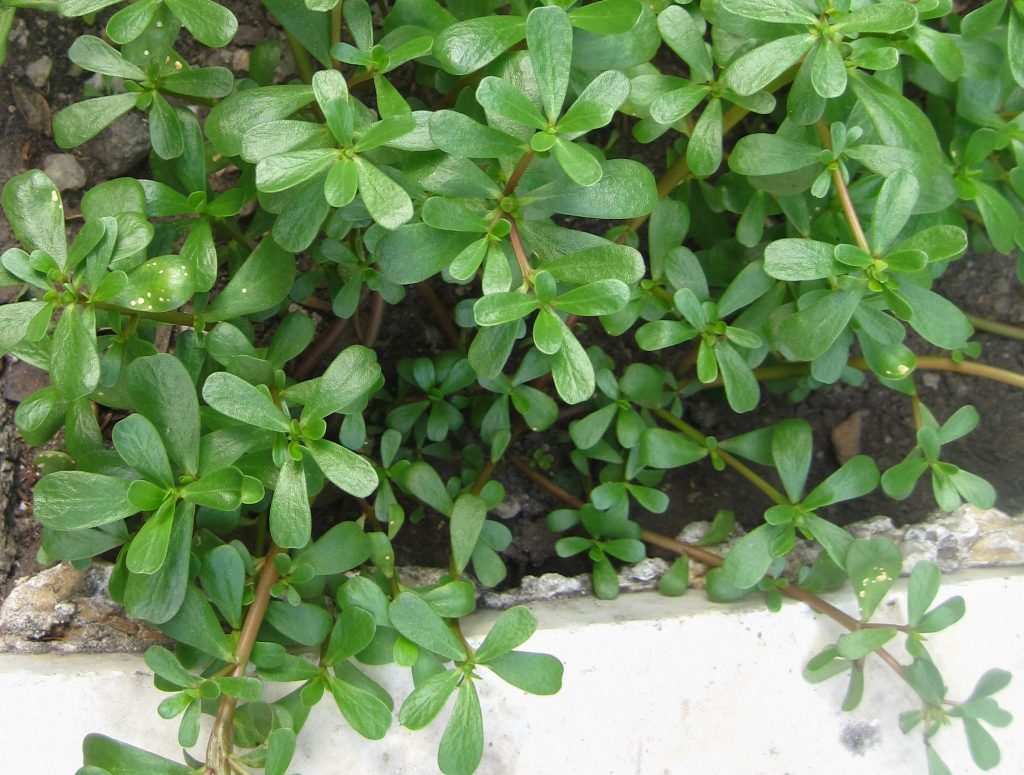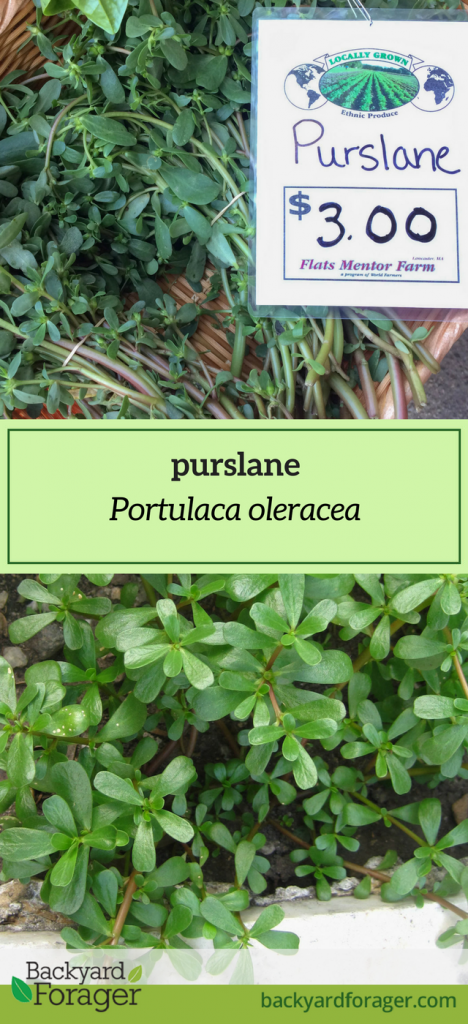
Next time you’re at the farmers’ market or in the produce section, look around for purslane. (In Spanish markets, you may find it labelled verdolagas.) This is the very same purslane that grows in between the vegetable rows in your garden, and between the pavement cracks in your driveway. The only difference is that store bought purslane has been washed, trimmed, and comes with a hefty price tag. Native to India and the Middle East, it’s appreciated as a food plant around the world. Yet here, most people pull it up as a weed. I’d like to change that.
If you don’t want to pay for your purslane, look for this plant in sunny, dry spots. This is an annual plant, with small, succulent, paddle-shaped leaves about an inch long. It produces small yellow flowers in mid to late summer. Wild purslane usually grows low and flat, hugging the ground. With more water and in richer soils, it has an upright growth habit and may be six to eight inches tall.
Purslane has a tart, lemony flavor and is high in iron, vitamins A & C, antioxidants, and omega 3 fatty acids. In fact, it is higher in omega 3 fatty acids than any other leafy green plant tested to date. Purslane has developed survival mechanisms that allow it to thrive in adverse conditions, especially drought. In addition to succulent leaf tissue and a waxy leaf covering (cuticle), it’s capable of photosynthesizing in two different ways. (Bear with me, this relates to flavor.)
In times of drought, purslane switches over from regular, C4 carbon fixation photosynthesis to CAM photosynthesis, in which the stomata open and close at night rather than during the day. The carbon dioxide taken in at night is transformed into malic acid, which is later converted to glucose. So, if your purslane is growing in hot, dry conditions and you want really sour flavor, harvest it early in the day, before the malic acid is converted to sugar.
Young, raw purslane is crunchy and slightly tart; the flavor is better, and the leaves are usually juicier, before the plant sets seed later in the growing season. If you find a nice patch and want to prolong your harvest, pinch off the top few inches of the plant on a regular basis. Regular pinching encourages branching and prevents flowering and seed development. If you’d like to guarantee that your purslane patch returns next year, at some point you’ll need to let the plant flower and set seed.
Young, tender purslane is great in salads and sandwiches. Pinch off the top few pairs of leaves to eat raw. Older, purslane is slightly mucilaginous (nothing like okra) and for this reason, I prefer it cooked. Thick stems of purslane make a tasty pickle and cooked purslane tastes something like lemony spinach, although the texture is quite different and it doesn’t reduce in volume like spinach does.
Purslane is great in egg dishes, stir-fries, and casseroles. It adds nutrition and substance to soups and stews. My preferred way to cook it is Purslane à la Grecque: sautéed with olive oil, feta, onions, and a few tomatoes for a delicious Mediterranean side dish. And then there’s Get Off My Lawn, a delicious, weedy cocktail. It combines purslane with tequila to make a deep green adult beverage. (Want to see how to make it? Click on the link above.)
Once you’ve tasted purslane, you may decide you want to grow your own. You can collect seed from existing plants (one plant may produce more than 100,000 seeds) or order it from a catalog. Plants can be harvested about six to eight weeks after planting.

Very interesting. I pull this weed all the time. Time to give it more respect!
Be careful it closely resembles a poisonous plant called spurge. spurge has thinner stem with milky discharge from stem
Hi Jodi, it’s always a good idea to be careful. Some people do confuse spurge (Euphorbia sp.) with purslane but only at an initial glance. If you look closely (and you won’t need a microscope!) there are several differences, including the milky, white sap (spurge) and thin stems (spurge), both of which you mention. Purslane is a succulent plant with thick, solid, green leaves. Spurge is not succulent; its leaves are much thinner and flatter. The leaves of E. maculata are often marked with a red spot at the center, while the leaves of E. prostrata are not. (Both share the common name spurge, and I’m not sure which one you mean.) Once you’ve seen both plants, it’s pretty easy to tell them apart. If you want purslane, remember the succulent leaves and the lack of white, milky sap. It’s always important to be 100% sure of the identity of your harvest before you eat it!
I’ve been eating it for years!! One of my spring/summer favorites!!
Had lots growing at Garden Root and to amazement of staff harvested and cooked it often, found info in article.Irony is have found plants and transplanted into large tray but they didn’t thrive will leave in flower beds next season.Holding thumbs!.
I haven’t heard the expression “holding thumbs” since I lived in Germany. Is that where you are?
Some of the purslane I harvested has white spots on it. Is it safe to eat.
Hi Arun, I’ll need to know more about those white spots before I can give you an answer. Do they rub off with your fingers? Are they part of the leaves (e.g. marks left behind in the leaf tissue by an insect), and therefore permanent. Your purslane MAY still be edible, but I can’t tell you without more info. If you’d like, you can post a photo on my FB page (https://www.facebook.com/thebackyardforager/) and maybe that will show me what I need to know.
Thank you Ellen. These white spots are permanent. I read on Google that they are some kind of fungus.
I’ve seen purslane with white spots caused by fungus, but permanent marks are often left behind by insects. If you’d like to post a photo (https://www.facebook.com/thebackyardforager/) I’d be happy to take a look, but without seeing the spots, I can’t make a guess.
A few months back I looked for and found purslane from the edible plants vendor at my farmer’s market. Brought it home and low and behold, now that I know what to look for, there’s purslane all over my garden. I’ve been popping it into green smoothies almost every day, freezing some for winter soups, and looking forward to a larger harvest next year. Thanks so much for these details. Very helpful and interesting.
I love hearing this, thanks for letting me know!
I found a small patch of purslane in my back yard but the flowers are red not yellow. How many different colors are there?
I’ve never seen purslane with red flowers. Please post a photo (showing the flower) on my FB page and I’ll take a look. https://www.facebook.com/thebackyardforager/
Hi do you have any fresh purslane with reddish stems please do let me know need about 5kg and more in coming months need to use for herbal medicine for cancer and diabetics
Thanks
Pravin
+447932655095
Hi Pravin, I see you’re in the UK. I don’t know what the weather is like where you are, but in most parts of the US, it’ll be months before we have fresh purslane again. Where I live there is snow on the mountains and it’s 25F (-4C).
yes, indeed